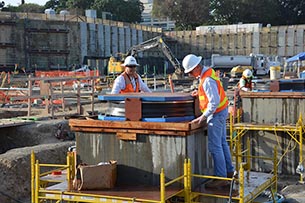Stanford Hospital Team Installs Base Isolators
 PALO ALTO, Calif. — Construction of the new 824,000-square-foot, 600-bed Stanford Hospital on the Stanford University Medical Center (SUMC) campus in Palo Alto is well underway. While the new facility will enhance capacity, it will also accommodate new medical technology as well as meet updated seismic safety requirements — a serious issue in the San Francisco Bay Area. As such, the project team recently reached an important phase after breaking ground in May 2013.
PALO ALTO, Calif. — Construction of the new 824,000-square-foot, 600-bed Stanford Hospital on the Stanford University Medical Center (SUMC) campus in Palo Alto is well underway. While the new facility will enhance capacity, it will also accommodate new medical technology as well as meet updated seismic safety requirements — a serious issue in the San Francisco Bay Area. As such, the project team recently reached an important phase after breaking ground in May 2013.
The Clark/McCarthy construction team, a joint venture between McCarthy Building Companies, Inc. and Clark Construction, is in the process of installing the project’s base isolators, a unique seismic safety system designed for this project. Base isolation works by dissipating earthquake-generated energy and will enable the new Stanford Hospital to withstand an 8.0 magnitude earthquake.
The project will feature 206 base isolators of two sizes that will be placed on pedestals in the building’s foundation, essentially acting as roller skates under the building during an earthquake. This allows the building to shift up to 6 feet — 3 feet each way — during a seismic event. The smaller of the base isolators weigh 2.5 tons each, and the larger ones weigh 4 tons each.
The base isolator system will help to ensure continuity of care in the event of an earthquake, which is essential given that Stanford Hospital is the only Level 1 Trauma Center in the region between San Francisco and San Jose.
The $2 billion hospital was designed by New York-based Rafael Viñoly Architects in association with Lee, Burkhart, Liu Inc., with offices in San Francisco, and will connect to the existing hospital via bridge and tunnel.
 The facility will include a flexible pavilion design with oversized windows allowing for natural light and views from the 368 patient rooms, which will total 600 patient beds on site after the addition. The project also features the new Level 1 Trauma Center — three times the size of the current emergency department — with 58 treatment bays; surgical, diagnostic and treatment rooms; a central courtyard; and a green roof.
The facility will include a flexible pavilion design with oversized windows allowing for natural light and views from the 368 patient rooms, which will total 600 patient beds on site after the addition. The project also features the new Level 1 Trauma Center — three times the size of the current emergency department — with 58 treatment bays; surgical, diagnostic and treatment rooms; a central courtyard; and a green roof.
“Technologically, it will be one of the most advanced hospitals in the world with all of the smart systems in place,” said Bert Hurlbut, vice president of construction for the Stanford Hospital project.
The facility, designed for LEED Silver certification, will feature a displaced ventilation system, which pushes air high and ventilates low, giving patients a comfortable flow of air. Plus, it uses less energy to run, Hurlbut said. The window system is also hooked up to the building automation system, so instead of turning on the air conditioning, the building will slowly lower the blinds to start blocking some of the sunlight.
The Stanford Hospital is part of the SUMC Renewal Project, which also includes the expansion of Lucile Packard Children’s Hospital, the renovation of Hoover Pavilion, the Welch Road Utility Project and the replacement of School of Medicine facilities. Scheduled for completion in 2017, the hospital is expected to open for patient care in early 2018 while remaining operational.
